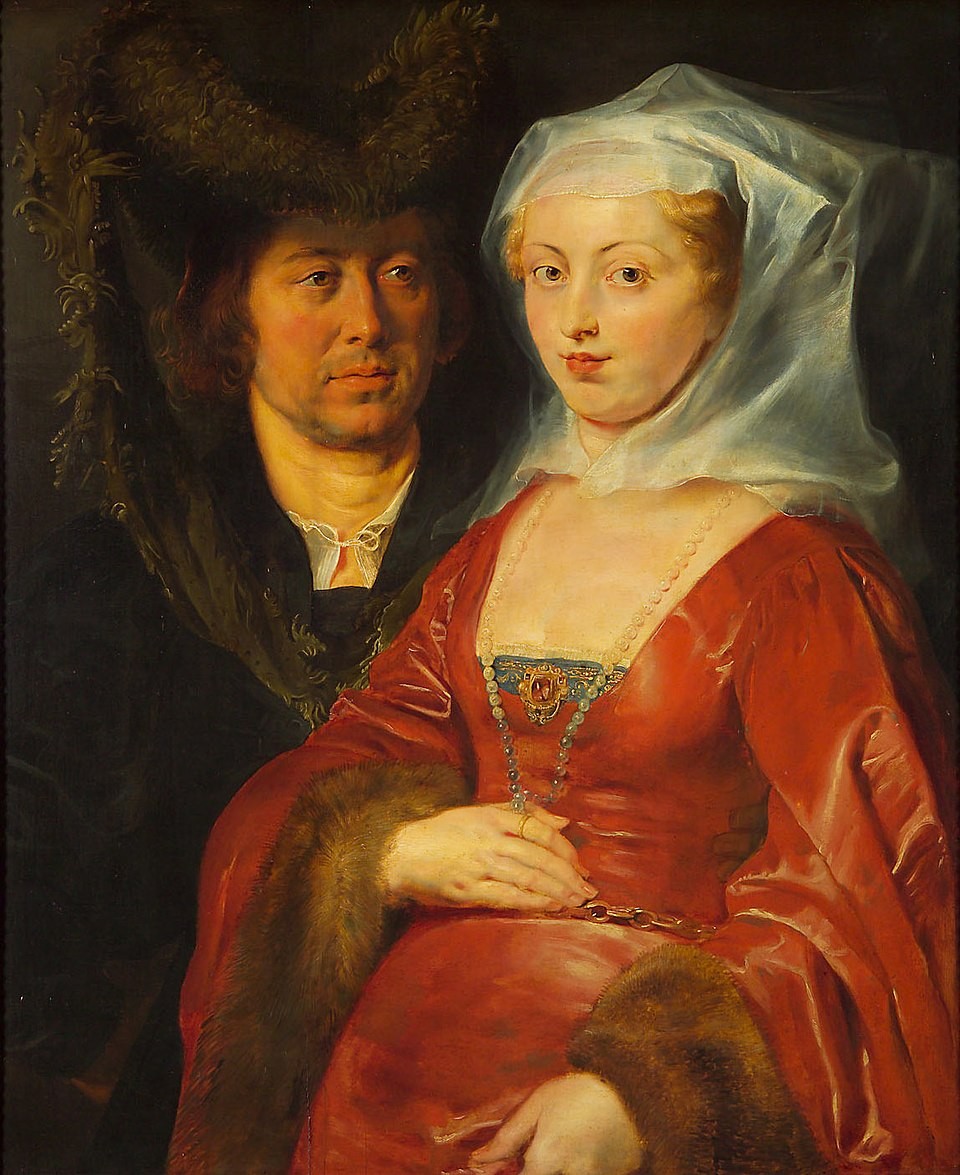Arnulfings
Alpaida
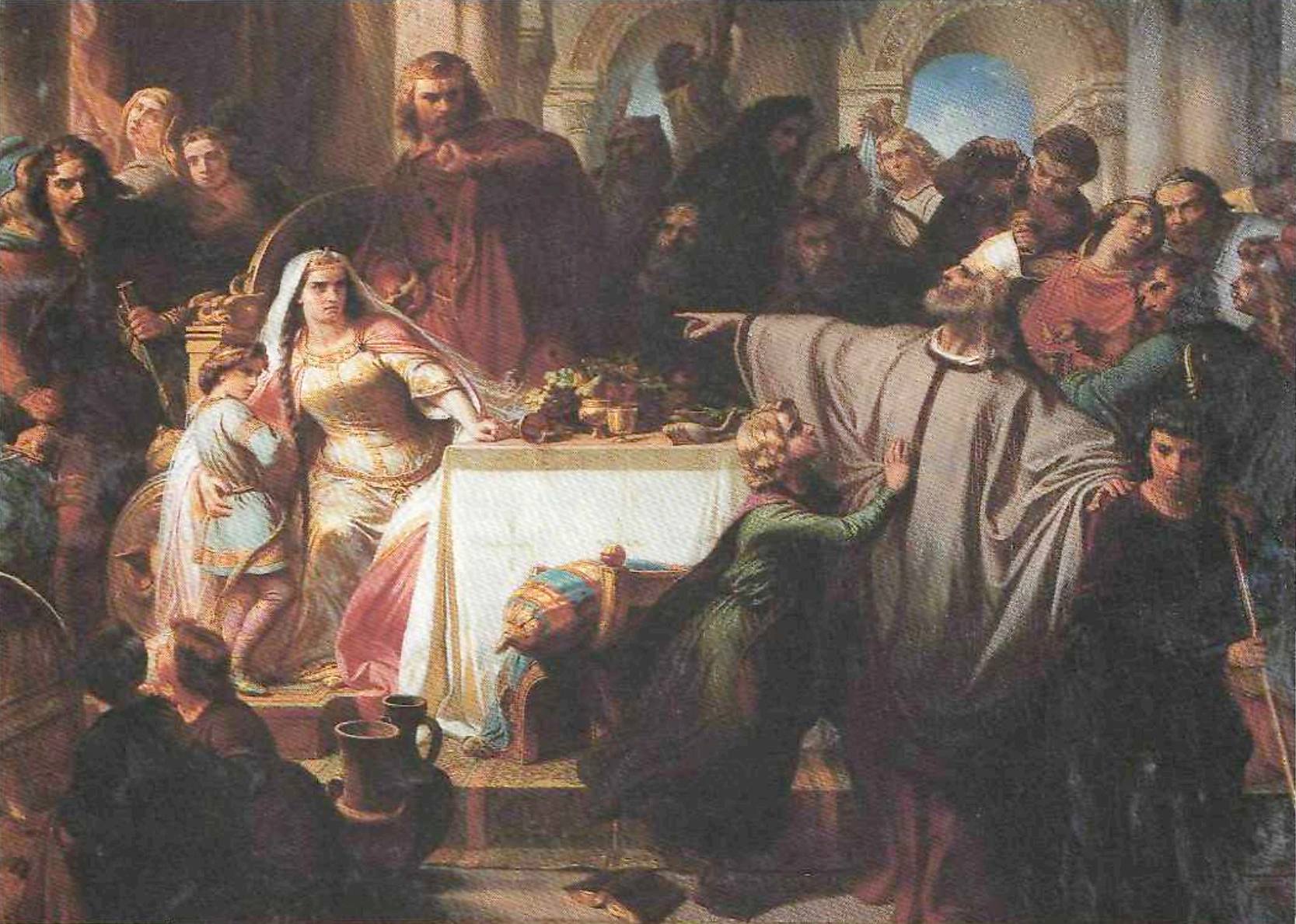 |
The Banquet
of Jupille, as imagined by August
Adolf Chauvin, dated 1861, in which Alpaida is berated by
Bishop Lambert of Maastricht for being a second wife to Pepin.
Pepin and Charles Martel are also depicted. |
Pepin II
The Fourth Book of the Chronicle of Fredegar with its
continuations p86 (trans. J. M. Wallace-Hadrill, 1960)
The aforesaid
Pippin took a second wife, the noble and lovely Alpaida. She gave him a
son, and they called him in his own language Charles. And the child
grew, and a proper child he undoubtedly was.
Topographia historica Gallo-Brabantiae p253
(Jacques Le Roy, 1692)
Ceterúm ne quis miretur Pippinum Principem viva Plectrude conjuge ſua,
Alpaidem in matrimonio habuiſſe puellam nobilem atque formoſam, ex qua
Carolum filium tulerit: notandum eſt morem ſuiſſe Francis, uxores malè
convenientes bonâ gratiâ dimittere, itaut vir & uxor alterius
matrimonij contrahendi haberent poteſtatem. Hunc morem indicat, qui
apud Marculfum Monachum exſtat, libellus repudij. Multi igitur
prætexentes ſe cum uxoribus concorditer & mutuo amore vivere non
poſſe, invitas dimittebant, ut alias ducerent. Nec Reges modo, qui
quidquid libuerit licere ſibi putant, ita faciebant: verumetiam
privati, quos uxorum ſuarum faſtidium ceperat, beneficio legis
utebantur. Conſtat Beppoleni Ducis filium præter ceteros tres uxores,
aliam poſt aliam, intra breve ſpatium repudiaviſſe. Id ſemper
improbavit ac multorum Conciliorum decretis damnavit Eccleſia, quæ
niſi ob adulterium uxorem à viro dimitti vetuit, ac ne tum quidem poſt
divortium factum aliam vivâ mœcha uxorem ducendi viro facultatem
dedit, pro adultero habens atque à communione removens, qui duxiſſet.
Sed nihilominús Pippinus Princeps amore Alpaidis captus fecit, quod
apud Francos fieri ſolebat atque etiam licebat: puellam formæ
excellentis vetulæ prætulit, atque effetæ, &c dimiſsa Plectrude
duxit Alpaidem. Sunt tamen, qui credunt numquam à Pippino repudiatam
ac domo ejectam ſuiſſe Plectrudem communium liberorum Drogonis &
Grimoaldi parentem, nunquam contra Canones legeſque Eccleſiæ ductam in
matrimonium Alpaidem. Quibus favere videtur Beda, quum tradit Pippinum
Ducem Francorum interpellatum à Plectrude conjuge, quam Blittridem
vocat, Suidberto locum habitandi in inſula quadam Rheni dediſſe. Certè
haud parum ſirmile veri eſt finxiſſe hoc in Principum ſuorum gratiam
auctores, qui dominantibus Pippini poſteris ſcripſere, & Alpaidem,
quæ viva Plectrude juſta & legitima Pippini conjux eſſe non
poterat, uxorem Pippini poſteriorem vocaviſſe, ne Carolus ex pellice
ſuſceptus crederetur, neu Regio generi aliqua inde nota inureretur.
Hactenus Valeſius;
This roughly translates as:
Moreover, lest anyone should be surprised that Prince Pepin, while his
wife Plectrude was alive, married a noble and beautiful girl, Alpaide,
by whom he had a son, Charles: it is to be noted that it is the custom
of the French to divorce wives who are not compatible with each other
with good grace, so that the husband and wife may have the power to
contract another marriage. This custom is indicated by the divorce
decree, which is extant in the writings of the monk Marculf. Many
therefore, on the pretext that they could not live with their wives in
harmony and mutual love, would divorce them unwillingly in order to
marry others. Nor did kings alone, who think that whatever they pleased
was permissible, do so: indeed even private individuals, who were seized
with disgust for their wives, availed themselves of the benefit of the
law. It is established that the son of Duke Beppoleni, in addition to
the others, divorced three wives, one after the other, within a short
space of time. This was always disapproved of and condemned by the
decrees of many Councils by the Church, which forbade a wife to be
divorced from her husband except for adultery, and even then, after the
divorce, did not give a husband the right to marry another living
adulteress, considering her an adulterer and removing from communion the
one who had married her. But the indifferent Prince Pepin, captivated by
the love of Alpaidis, did what was customary and even permitted among
the Franks: he preferred a girl of excellent beauty to an old woman, and
having dismissed Plectrude, &c., married Alpaidis. There are,
however, who believe that Plectrude, the mother of the common children
Drogon and Grimoald, was never repudiated and thrown out of her home by
Pepin, and that Alpaidis was never married to him against the Canons and
laws of the Church. Bede seems to favor them, when he reports that
Pepin, Duke of the Franks, being interrogated by his wife Plectrude,
whom he calls Blittride, gave Suidbert a place to live on a certain
island in the Rhine. Certainly it is not a little true that the authors
who wrote to the ruling descendants of Pepin fabricated this for the
sake of their princes, and called Alpaide, who could not have been the
just and legitimate spouse of Pepin while he was alive, the wife of
Pepin, lest Charles be believed to have been born of a concubine, or
that some knowledge of it might be insinuated to the King's son-in-law.
Ansegisel
 |
|
Depiction of Ansegisel in the Carolingian
Family Tree in the Chronicon Universale, created in the 12th
century.
|
Arnulf
Doda
Begga
Ansegisel was an official
(domesticus) in the household of king Sigebert
III of Austrasia.
The Dark Ages, 476-918 p178 (Charles
William Chadwick Oman, 1898)
Towards
the end of his reign, Chlothar II. made his son Dagobert
king of Austrasia, while he was still a very young man. The chief
councillors by whose aid Dagobert administered his realm were two men
whose names form a landmark in Frankish history — Arnulf, bishop of Metz
and count Pippin the elder, the ancestors of the great house of the
Karlings. Bishop Arnulf was the wisest and best of the prelates of
Austrasia, and, after a long life of usefulness in church and state, won
the name of saint by laying down his crozier and ring and retiring to a
hermitage, to spend his last fifteen years in the solitudes of the
Vosges. Count Pippin, a noble from the land between Meuse and Mosel,
whose ancestral abodes are said to have been the manors of Hersthal and
Landen, was appointed mayor of the palace, and lived in the closest
concord and amity with Arnulf. They cemented their alliance by a
marriage, Begga, the daughter of Pippin, being wedded to Ansigisel, the
son of the bishop; for Arnulf, like many of the Frankish clergy, lived
in lawful wedlock. From these parents sprang the whole of the line of
mayors, kings, and emperors whose mighty deeds were to make their
comparatively unimportant ancestors famous in history
murdered in a feud with Gundoen
Arnulf
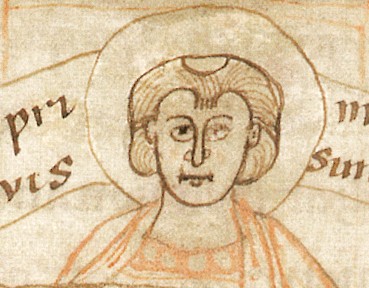 |
|
Depiction of Arnulf in the Carolingian
Family Tree in the Chronicon Universale, created in the 12th
century.
|
Doda
See Sigeberti Chronica in Monumenta
Germaniæ Historica SS 6 p324 (ed. G. H. Pertz, 1844)
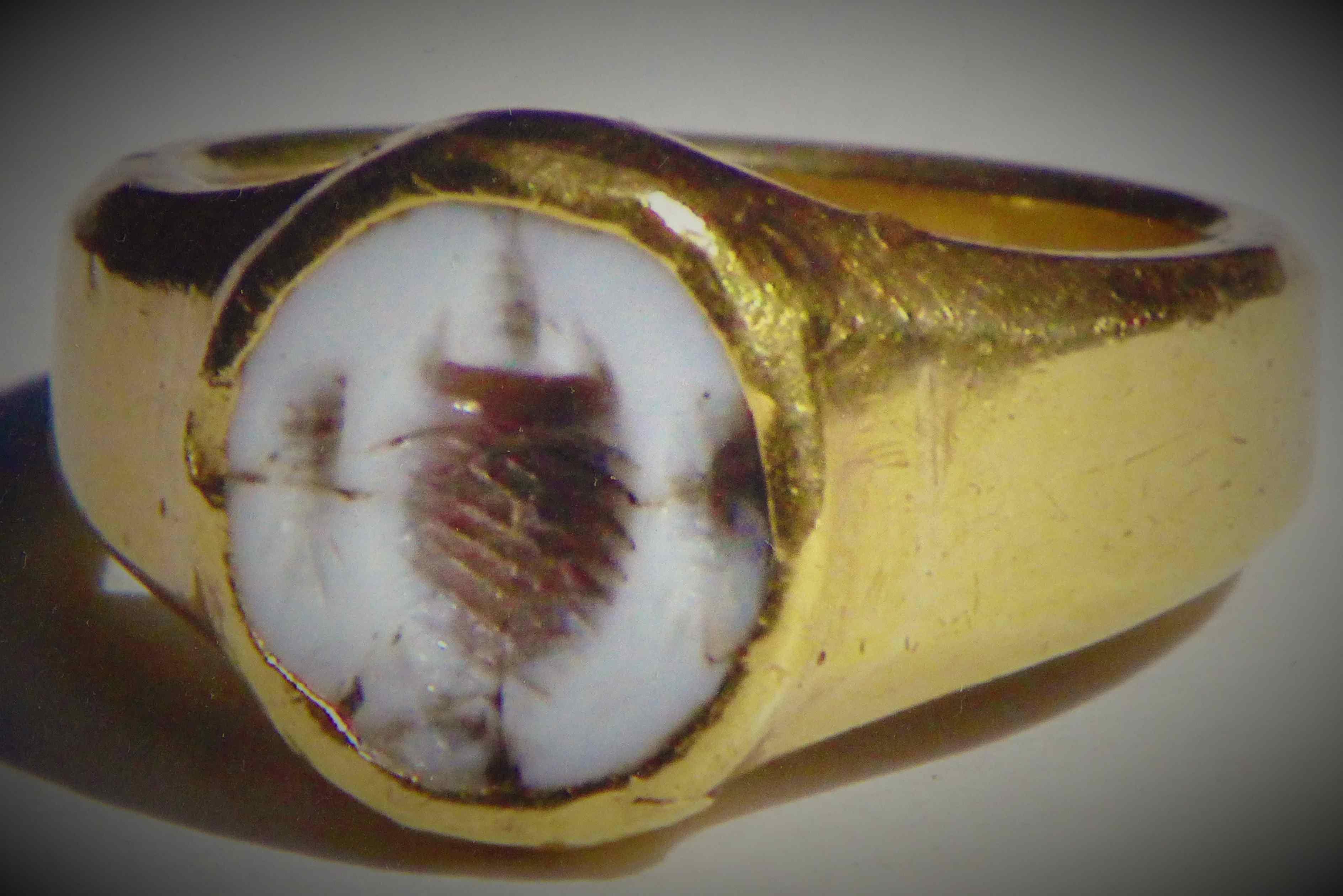 |
The large Bishop's ring made of stone and
gold, called the Ring of Saint Arnoul, made in the 7th
century. It is one of the oldest Bishop's rings still
existing and is now held in the Metz
Cathedral Treasury
|
Bishop of Metz
Arnoulf was bishop of Metz,
the capital of Austrasia,
for 15 years. In 629 he retired to become a monk at Remiremont
abbey, in the Vosges
mountains. Arnoulf is venerated as a saint by the Catholic church. His
feast day is July 18.
A life of Arnulf, Vita Sancti Arnulfi, was written (in Latin)
shortly after his death. Some excerpts:
Vita Sancti Arnulfi in Monumenta
Germaniae Historica pp432-44 (1888)
INCIPIT
VITA SANCTI ARNULFI EPISCOPI ET CONFESSORIS.
… 1. Beatus igitur Arnulfus episcopus prosapic genitus Francorum,
altus satis et nobilis parentibus atque oppulentissimus in rebus
saeculi fuit; sed nobilior deinceps et sublimior in fide Christi
permansit.
… 3. Cumque iam bene edoctus ad roboratam pervenisset aetatem,
Gundulfo subregulo seu etiam rectori palatii vel consiliario regis
exercitandus in bonis actibus traditur. Hunc ille cum accepisset, per
multa deinceps experimenta probatum iamque Teutberti regis ministerio
dignum aptavit.
… 5. Interea igitur, vix cogentibus amicis atque parentibus, inclitam
et nobilissimam a gente puellam, quia Deus sic voluit, praeclaris
moribus duxit uxorem. Nam illud eidem Dominus speciale munus veluti
duarum gemmarum splendidum decus in mundo indulsit, ut ex eadem
egregia femina duorum filiorum gaudia suscepisset.
… [614] 7. Cumque in his adque diversis bonis tamquam potentissimus
auriga iugiter invigilaret, forte fuit, ut urbs Metensium praesule
indigeret. Tunc una vox populorum Arnulfum domesticum adque
consiliarium regis dignum esse episcopum adelamavit. Ille autem
lacrimans et conpulsus, quia Deo ita placitum fuit, urbem at
gubernandum suscepit, sicque deinceps episcopales gestans infulas, ut
eciam domesticatus sollicitudine adque primatum palacii hacsi nollens
teneret.
… [629] 19. Post haec autem paucis temporibus actis, viro iusto iugi
intencione pulsante, sancetus Goericus cognomento Abbo huius successor
eligitur, Digne quippe a Domino hactum est, ut sancto sanctus
succederet. Quo audito, vir egregius Romaricus a partibus Vosago
egressus, ad beatum pergit Arnulfum adque ex convenencia utriusque
infra vasta heremi aptum eidem praeparat locum.
… 21. INCIPIT TRANSITUS SANCTI ARNULFI EPISCOPI. OBIIT AUTEM 15. KAL.
AG.,
… 22. Siquidem vir egregius Romaricus adducit sanctissimum corpus
illius; cum dignitate et honore quo valuit in castello Habendum
sepulturae tradidit.
23. Post annos fere iam acto tempore vir electissimus successor
eius Goericus episcopus, consilium inito, coacervata clericorum seu
eciam et populorum ingente caterva, acceptis quoque duobus episcopis,
sic una pariter pergunt ad heremum. Co in loco excubias cum reverencia
caelebrantes, saneta membra ab urna lapidis auferentes, grabato
inponunt, adque mox arripientes itinera, cum gaudio remeant ad urbem;
… 26. Post haec autem cum magna prosperitate et laeticia ad urbem
perveniunt. Eece! mox omnis eivitas cum crucibus et cereis atque
ingenti gaudio et admiracione obviam eurrit et pastorem suum, quem
dudum iudicium fugacem amiserunt, caelum iam regnantem repereunt adque
sacrum corpus illius in basilicam sanctorum apostolorum cum reverencia
et grandi exultacione sepulturae recondunt.
This roughly translates as:
THE LIFE OF
SAINT ARNULPH, BISHOP AND CONFESSOR, BEGINS.
… 1. Blessed Arnulf, bishop, was born of the Frankish stock, was quite
high and noble in his parents, and very wealthy in worldly things; but
he remained nobler and more exalted in the faith of Christ.
… 3. And when
he had already reached a strong age, having been well-educated, he was
handed over to Gundulf, the subregent, or even the rector of the palace,
or the king's councillor, to be trained in good deeds. When he had
received him, he tested him through many experiments and made him fit
for the service of King Teutbert.
… 5. Meanwhile, therefore, with scarcely any coercion from friends and
parents, he married a famous and noble girl of the nation, because God
so willed it, and of excellent character. For the Lord bestowed upon him
that special gift, like the splendid beauty of two gems in the world,
that he should have received the joys of two sons from that excellent
woman.
… [614] 7. And while he was constantly watching over these and other
various goods as a most powerful charioteer, it happened that the city
of Metz needed a bishop. Then one voice of the people proclaimed Arnulf,
the king's household and counselor, as a worthy bishop. But he, weeping
and moved, because it was so pleasing to God, undertook to govern the
city, and so from then on, wearing episcopal robes, he also,
domesticated with solicitude, held the primacy of the palace, even
though he did not want to.
… [629] 19. After a few days, however, the just man, with his constant
determination, chose the saintly Goeric, surnamed Abbo, as his
successor. For it was fittingly ordained by the Lord that he should
succeed the saint. Hearing this, the excellent man Romaric, leaving the
parts of Vosago, went to the blessed Arnulf, and by agreement of both,
prepared a suitable place for him in the vast hermitage.
… 21. THE PASSING OF SAINT ARNULPH, BISHOP, BEGINS. HE DIED BUT ON THE
15TH DAY OF THE KALENDS OF AUGUST.
… 22. Indeed, the excellent man Romaricus brought his most holy body
and, with the dignity and honor that he was able to have in the castle
of Habendum, he delivered it for burial.
23. After almost a year, when the time had come, his most chosen
successor, Bishop Goericus, having taken counsel, gathered together a
great company of clerics, or even of the people, and having taken also
two bishops, they proceeded together to the hermitage. Having celebrated
the vigils with reverence in the place, they removed the healthy limbs
from the stone urn, laid them on a stretcher, and soon took their
journeys, and returned with joy to the city.
… 26. After this, however, they arrive at the city with great prosperity
and joy. Lo! soon all the people come to meet them with crosses and
candles and with great joy and amazement, and they find their shepherd,
whom they had long since lost in a fleeting judgment, now reigning in
heaven, and they bury his sacred body in the basilica of the holy
apostles with reverence and great exultation.
The lives of the fathers, martyrs, and other principal
saints vol 7 pp147-8 (Alban Butler, 1846)
JULY
18.]
ST. ARNOUL, BISHOP OF METZ, C.
AMONG the illustrious saints who adorned the court
of king Clotaire the Great, none is more famous than St. Arnoul. He was
a Frenchman, born of rich and noble parents; and, having been educated
in learning and piety, was called to the court of king Theodebert, in
which he held the second place among the great officers of state, being
next to Gondulph, mayor of the palace. Though young, he was equally
admired for prudence in the council and for valor in the field. By
assiduous prayer, fasting, and excessive alms-deeds, he joined the
virtues of a perfect Christian with the duties of a courtier. Having
married a noble lady called Doda, he had by her two sons, Clodulf and
Ansegisus; by the latter the Carlovingian race of kings of France
descended from St. Arnoul. Fearing the danger of entangling his soul in
many affairs which passed through his hands, he desired to retire to the
monastery of Lerins; but being crossed in the execution of his project,
passed to the court of king Clotaire. That great monarch, the first year
in which he reigned over all France, assented to the unanimous request
of the clergy and people of Metz, demanding Arnoul for their bishop. Our
saint did all that could be done to change the measures taken, but in
vain. He was consecrated bishop in 614, and his wife Doda took the
religious veil at Triers. The king obliged Arnoul still to assist at his
councils, and to fill the first place at his court. The saint always
wore a hair shirt under his garments; he sometimes passed three days
without eating, and his usual food was only barley and water. He seemed
to regard whatever he possessed as the patrimony of the poor, and his
alms seemed to exceed all bounds. His benevolence took in all the
objects of charity, but his discretion singled out those more
particularly whose greater necessities called more pressingly upon his
bounty.
In 622 Clotaire II. divided his dominions, and making his son
Dagobert king of Austrasia, appointed St. Arnoul duke of Austrasia and
chief counsellor and Pepin of Landen mayor of his palace. The reign of
this prince was virtuous, prosperous, and glorious, so long as Arnoul
remained at the helm; but the saint anxiously desiring to retire from
all business, that he might more seriously study to secure his own
salvation before he should be called hence, never ceased to solicit the
king for leave to quit the court. Dagobert long refused his consent, but
at length, out of a scruple lest he should oppose the call of heaven,
granted it, though with the utmost reluctance. St. Arnoul resigned also
his bishopric, and retired into the deserts of Vosge, near the monastery
of Remiremont, on the top of a high mountain, where a hermitage is at
this day standing. Here the saint labored daily with fresh fervor to
advance in the path of Christian perfection; for the greater progress a
person has already made in virtue, the more does the prospect enlarge
upon him, and the more perfectly does he see how much is yet wanting in
him, and how great a scope is left for exerting his endeavors still
more. Who will pretend to have made equal advances with St. Paul towards
perfection? yet he was far from ever thinking that he had finished his
work, or that he might remit anything in his endeavors. On the contrary,
we find him imitating the alacrity of those who run in a race who do not
so much consider what ground they have already cleared, as how much
still remains to call forth their utmost eagerness and strength. Nor can
there be a more certain sign that a person has not yet arrived at the
lowest and first degree of virtue, than that he should think he does not
need to aim higher. In this vigorous pursuit St. Arnoul died on the 16th
of August in 640. His remains were brought to Metz, and enrich the great
abbey which bears his name. The Roman Martyrology mentions him on the
18th of July, on which day the translation of his relics was performed;
the Gallican on the 16th of August. See his life, faithfully compiled by
his successor, in Mabillon, Act. Bened. t. 2, p. 150. Also Calmet, Hist.
de Lorraine, t. 1, 1. 9, n. 10, &c. p. 378, 381, &c. Bosch the
Bollandist, t. 5, Jul. p. 423; and D. Cajot, Benedictin monk of St.
Arnoul’s Les Antiquités de Metz, an. 1761.
The Dark Ages, 476-918 p178 (Charles
William Chadwick Oman, 1898)
Towards
the end of his reign, Chlothar II. made his son Dagobert
king of Austrasia, while he was still a very young man. The chief
councillors by whose aid Dagobert administered his realm were two men
whose names form a landmark in Frankish history — Arnulf, bishop of Metz
and count Pippin the elder, the ancestors of the great house of the
Karlings. Bishop Arnulf was the wisest and best of the prelates of
Austrasia, and, after a long life of usefulness in church and state, won
the name of saint by laying down his crozier and ring and retiring to a
hermitage, to spend his last fifteen years in the solitudes of the
Vosges. Count Pippin, a noble from the land between Meuse and Mosel,
whose ancestral abodes are said to have been the manors of Hersthal and
Landen, was appointed mayor of the palace, and lived in the closest
concord and amity with Arnulf. They cemented their alliance by a
marriage, Begga, the daughter of Pippin, being wedded to Ansigisel, the
son of the bishop; for Arnulf, like many of the Frankish clergy, lived
in lawful wedlock. From these parents sprang the whole of the line of
mayors, kings, and emperors whose mighty deeds were to make their
comparatively unimportant ancestors famous in history.
16 August 640
Catalogus
Episcoporum Mettensium in Monumenta
Germaniæ Historica SS 2 p269 (ed. G. H. Pertz, 1829)
29.
Arnulfus episcopus sedit annos 15. et dies 10. obiit 17. Kal. Septemb.
This roughly translates as:
29. Bishop
Arnulf sat for 15 years and 10 days. He died on the 17th day before the
Kalends of September [16 August]
Sigeberti
Chronica in Monumenta Germaniæ Historica
SS 6 p324 (ed. G. H. Pertz, 1844)
640.
Sanctus Arnulfus ex maiore domus Mettensium episcopus, et ex episcopo
solitarius, dormit in Christo.
A date of 18 July is recorded for Arnulf's death in Vita Sancti Arnulfi in Monumenta
Germaniae Historica p441 and 18 July is the recognised feast
day of St Arnulph. Alban Butler in The lives of the fathers, martyrs, and other principal
saints vol 7 p148 states that Arnulf's death was on 16
August 640 and that 18 July was the date of the translation of his relics.
Remiremont
abbey on Mount Habendum, then transferred to the Abbey
of Saint-Arnould in Metz in 641
- Sigeberti Chronica in Monumenta
Germaniæ Historica SS 6 p324 (ed. G. H. Pertz, 1844); The lives of the fathers, martyrs, and other
principal saints vol 7 p147 (Alban Butler, 1846); Medieval
Lands (ARNOUL)
- Sigeberti Chronica in Monumenta
Germaniæ Historica SS 6 p324 (ed. G. H. Pertz, 1844); The lives of the fathers, martyrs, and other
principal saints vol 7 p147 (Alban Butler, 1846); Medieval
Lands (ARNOUL); wikipedia
(Arnulf of Metz)
- Vita Sancti Arnulfi in Monumenta
Germaniae Historica pp434-5 (1888); Catalogus Episcoporum Mettensium in Monumenta Germaniæ Historica SS 2 p269
(ed. G. H. Pertz, 1829); The lives of the fathers, martyrs, and other
principal saints vol 7 p148 (Alban Butler, 1846); The Dark Ages, 476-918 p178 (Charles
William Chadwick Oman, 1898); Medieval
Lands (ARNOUL); wikipedia
(Arnulf of Metz)
- Vita Sancti Arnulfi in Monumenta
Germaniae Historica pp432-44 (1888); The lives of the fathers, martyrs, and other
principal saints vol 7 pp147-8 (Alban Butler, 1846); The Dark Ages, 476-918 p178 (Charles
William Chadwick Oman, 1898); Medieval
Lands (ARNOUL); wikipedia
(Arnulf of Metz)
- Vita Sancti Arnulfi in Monumenta
Germaniae Historica p441; Sigeberti Chronica in Monumenta
Germaniæ Historica SS 6 p324 (ed. G. H. Pertz, 1844); Catalogus Episcoporum Mettensium in Monumenta Germaniæ Historica SS 2 p269
(ed. G. H. Pertz, 1829); The lives of the fathers, martyrs, and other
principal saints vol 7 p148 (Alban Butler, 1846); Medieval
Lands (ARNOUL); wikipedia
(Arnulf of Metz)
- Vita Sancti Arnulfi in Monumenta
Germaniae Historica pp442-44 (1888); The lives of the fathers, martyrs, and other
principal saints vol 7 p148 (Alban Butler, 1846); Medieval
Lands (ARNOUL)
Doda
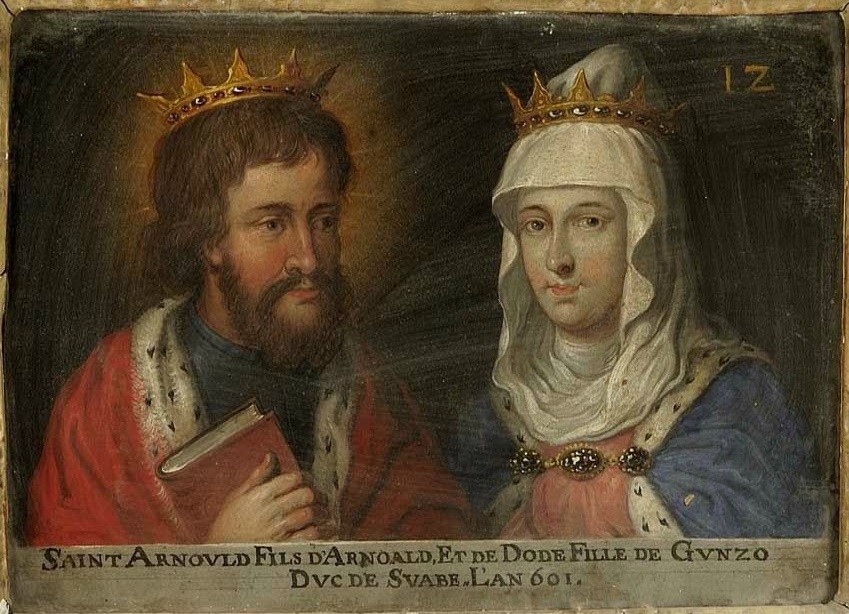 |
Arnulf and Doda imagined in an oil on
copper painting from the second half of the 17th century. It is
one of a series of sixty paintings known as "double Lorraine
portraits". The legend "SAINT ARNOVLD FILS D'ARNOVLD, ET DE DODE
FILLE DE GVNZO DVC DE SVABE. L'AN 601" names Arnulf and Doda, but
the parents given are dubious. The painting is now held in the Gallaria
Palatina in Florence. |
Arnulf
The Sigeberti Chronica names Doda as the mother of Clodulfus who was the son
of Arnulf, and notes that she retired to Trier as a nun.
Sigeberti
Chronica in Monumenta Germaniæ Historica
SS 6 p324 (ed. G. H. Pertz, 1844)
640.
Sanctus Arnulfus ex maiore domus Mettensium episcopus, et ex episcopo
solitarius, dormit in Christo. Clodulfus filius eius, post Mettensis
episcopus sanctitatem patris imitatur. Doda mater ipsius Clodulfi,
Treveris reclusa, Christo ancillatur.
This roughly translates as:
Saint Arnulf,
bishop of Metz, a great man, and a solitary bishop, sleeps in Christ.
His son Clodulf, later bishop of Metz, imitates his father's holiness.
Doda, the mother of Clodulf himself, is a recluse in Trier, and is a
handmaid of Christ.
Doda is not named, but the wife of Arnulf is described in Vita Sancti Arnulfi as "a famous and noble
girl of the nation".
Vita Sancti Arnulfi in Monumenta
Germaniae Historica p433 (1888)
INCIPIT
VITA SANCTI ARNULFI EPISCOPI ET CONFESSORIS.
… 5. Interea igitur, vix cogentibus amicis atque parentibus, inclitam
et nobilissimam a gente puellam, quia Deus sic voluit, praeclaris
moribus duxit uxorem. Nam illud eidem Dominus speciale munus veluti
duarum gemmarum splendidum decus in mundo indulsit, ut ex eadem
egregia femina duorum filiorum gaudia suscepisset.
This roughly translates as:
THE LIFE OF
SAINT ARNULPH, BISHOP AND CONFESSOR, BEGINS.
… 5. Meanwhile, therefore, with scarcely any coercion from friends and
parents, he married a famous and noble girl of the nation, because God
so willed it, and of excellent character. For the Lord bestowed upon him
that special gift, like the splendid beauty of two gems in the world,
that he should have received the joys of two sons from that excellent
woman.
Vita S. Chlodulfi Episcopi Mettensis in Acta Sanctorum Ordinis S. Benedicti pp998-9
(1733)
Mater
vero Domni & venerabilis Chlodulfi DODA nuncupata
non minori nobilitate clara refulſit ſed hanc ipſam nobilitatem morum
pietate & animi ſanctitate glorioſiſſime illuſtravit ac decoravit.
Quæ cum viro pudiciſſime prout fert mundus vivens, non patiebatur
bonorum operum exhibitione ſe imparem fore: ut dum B. Arnulfus
Pontificali Cathedra ſublimatus eſt ipſa etiam fervente in ea
igneSpiritus-ſancti non ſolum ſpirituali veſte & velamine induta
eſt verumetiam apud Treverenſes incluſione uſque ad diem mortis ſeſe
retruſit atque relegavit.
This roughly translates as:
But the mother
of the Lord and venerable Clodulph, called Doda, shone with no less
nobility, but she most gloriously illustrated and adorned this very
nobility by piety of manners and holiness of mind. She did not suffer
herself to be unequal to a man most modest, as the living world bears,
in the display of good works: so that when Blessed Arnulf was exalted to
the Pontifical Chair, she herself, with the fire of the Holy Spirit
burning in it, was not only clothed with the spiritual garment and veil,
but also, by confinement among the Treverans, she withdrew and exiled
herself until the day of her death.
Pepin II
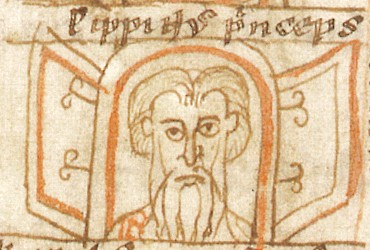 |
|
Depiction of Pepin II in the Carolingian
Family Tree in the Chronicon Universale, created in the 12th
century.
|
Ansegisel
Begga
Plectrude
Alpaida
The Fourth Book of the Chronicle of Fredegar with its
continuations p86 (trans. J. M. Wallace-Hadrill, 1960)
The aforesaid
Pippin took a second wife, the noble and lovely Alpaida. She gave him a
son, and they called him in his own language Charles. And the child
grew, and a proper child he undoubtedly was.
Pepin also had at least one other child outside of his marriages.
mayor of the palace of
Austrasia, Neurstria and Burgundy
Pepin was a military leader who was the de facto ruler of Francia. He was mayor of the
palace of Austrasia
from 680 until his death, as well as mayor of the palace of Neustria
and of Burgundy from
687. He took the title of duke
and prince of the Franks upon his conquest of all the Frankish realms
in 687.
The Encyclopaedia Britannica 11th edition vol
21 pp635-6 (ed. Hugh Chisholm, 1911)
PIPPIN
II. (d. 714), incorrectly called Pippin of Herstal, was son of
Adalgiselus (son of Arnulf, bishop of Metz) by a daughter of Pippin I.,
called in later documents Begga. Towards 678 he placed himself at the
head of the great nobles in Austrasia to combat Ebroïn, the mayor of the
palace, and Neustria. After some reverses he gained a great victory
after Ebroïn’s death at the battle of Tertry, not far from St Quentin.
This victory made Pippin almost entire master of Gaul. He appointed one
of his sons mayor of the palace of Neustria, reserving for another of
his sons the mayoralty of Austrasia. He made war on the Frisians and
defeated their duke Radbod; and part of this people became converts to
Christianity. He also defeated Willari, the duke of the Alamanni, and
subdued his country. The Bavarians, too, recognized the Frankish
suzerainty. The plans he had formed for reforming the church and
convoking councils were interrupted by his death, which took place on
the 16th of December 714.
The Annales Mettenses in Monumenta
Germaniæ Historica SS 1 pp316-22 (ed. G. H. Pertz, 1826)
contains a history and biography of Pepin (in Latin).
16 December 714
Annales Mettenses Priores p19 (ed.
Berhard von Simson, 1905)
[714]
Eodem quoque anno Pippinus princeps iterum molestia corporali
correptus, circumsitis gentibus Francorum dominationi subactis, in
pace obiit XVII. Kal. Ian. Rexit autem populum Francorum annis XXVII
et mensibus sex.
This roughly translates as:
[714] In the
same year also, prince Pepin, being again seized with bodily trouble,
having subjected the surrounding nations to the dominion of the Franks,
died in peace on the 17th day before the Kalends of January [16
December]. He ruled the people of the Franks for 27 years and six
months.
Return to Chris Gosnell's Home Page
If you have any comments, additions or modifications to the information on this page, please feel free to email me.
Created and maintained by: chris@ocotilloroad.com

